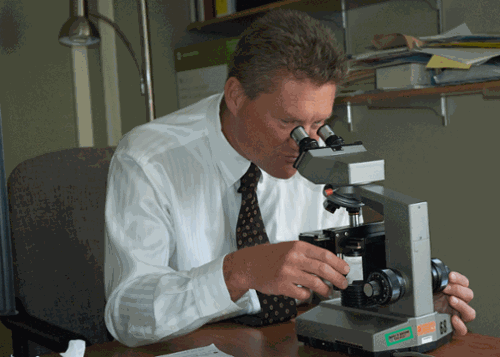Research Area(s)
- Heat Shock Proteins
About
Cells respond to stressful conditions and environmental insult by increasing expression of protective heat shock proteins (hsps). The response is controlled by heat shock factor 1 (HSF1). This transcription factor exists a single inactive protein, that becomes activated by refolding into trimers and phosphorylation that is probably controlled by a number of cell signaling pathways. However, we do not yet know the mechanisms by which cells respond to stress and modulate the activity of HSF1.
My lab has three major areas of study regarding stress gene regulation. Cellular signaling to HSF1, folding of HSF1 by molecular chaperones, and activation of HSF1 in cardiac tissue. We use a variety of mammalian cell culture and tissue explant models, and we use frog (Xenopus) oocytes as s model system for biochemical analyses. These studies are supported by grants from CIHR and the Heart and Stroke Foundation.
A second area of interest in our lab is how organisms regulate gene expression during embyrogenesis. Our particular focus is on the transcription factor YY1 and its regulation during frog development. These studies are supported by a grant from NSERC.
Selected Publications
- Nair M, Belak ZR, Ovsenek N.Effects of fluoride on expression of bone-specific genes in developing Xenopus laevis larvae. Biochem Cell Biol. 2011 Aug;89(4):377-86. doi: 10.1139/O11-034. Epub 2011 Jul 26.
- Belak ZR, Nair M, Ovsenek N. Parameters for effective in vitro production of zinc finger nucleic acid-binding proteins. Biotechnol Appl Biochem. 2011 May;58(3):166-74. doi: 10.1002/bab.24. Epub 2011 May 10.
- Taherian A, Ovsenek N, Krone PH. Expression of hsp90 alpha and hsp90 beta during Xenopus laevis embryonic development. Iran Biomed J. 2010 Oct;14(4):127-35.
- Conde R, Belak ZR, Nair M, O'Carroll RF, Ovsenek N. Modulation of Hsf1 activity by novobiocin and geldanamycin. Biochem Cell Biol. 2009 Dec;87(6):845-51.
- Taherian A, Krone PH, Ovsenek N. A comparison of Hsp90alpha and Hsp90beta interactions with cochaperones and substrates. Biochem Cell Biol. 2008 Feb;86(1):37-45.
- Belak ZR, Ficzycz A, Ovsenek N. Biochemical characterization of Yin Yang 1-RNA complexes. Biochem Cell Biol. 2008 Feb;86(1):31-6.
- Belak ZR, Ovsenek N. Assembly of the Yin Yang 1 transcription factor into mRNPs requires direct RNA-binding activity.
- J Biol Chem. 2007 Nov 1; [Epub ahead of print] Popescu BF, Belak ZR, Ignatyev K, Ovsenek N, Nichol H. Asymmetric distribution of metals in the Xenopus laevis oocyte: a synchrotron X-ray fluorescence microprobe study.
- Biochem Cell Biol. 2007 Oct;85(5):537-42. Evans TG, Belak Z, Ovsenek N, Krone PH. Heat shock factor 1 is required for constitutive Hsp70 expression and normal lens development in embryonic zebrafish.
- Comp Biochem Physiol A Mol Integr Physiol. 2007 Jan;146(1):131-40. Epub 2006 Oct 6. Conde, R., Xavier, J., McLoughlin, C., Chinkers, M., and Ovsenek, N., 2005. Protein phosphatase 5 is a negative modulator of heat shock factor 1. Journal of Biological Chemistry. 2005 Aug 12; (32):28989-96. Epub 2005 Jun 20.
- Diaz-Camino C, Conde R, Ovsenek N, Villanueva MA, 2005. Actin expression is induced and three isoforms are differentially expressed during germination in Zea mays. Journal of Experimental Botany. 56(412):557-565
- G.F. Davies, W.J. Roesler, N. Ovsenek, and L. Bharadwaj, 2003. Troglitazone reduces Hsp70 content in primary rat hepatocytes by a ubiquitin proteasone independent mechanism. Pharmacological Research, 48: 119-126.
- L.A. Bharadwaj, G.F. Davies, I.J. Xavier and N. Ovsenek, 2002. L-carosine and vermapamil inhibit hypoxia-induced expression of hypoxia inducible factor (HIF-1 alpha) in H9c2 cardiomyoblasts. Pharmacological Research, 45(3): 175-191.
- A. Ficzycz, and N. Ovsenek, 2002. The yin yang 1 transcription factor associates with ribonucleoprotein (mRNP) complexes in the cytoplasm of Xenopus oocytes. J Biol Chem, 277: 8382-8387.
- Ficzycz A, Eskiw C, Meyer D, Eliassen-Marley K, Hurt M, Ovsenek N. 2000. Expression, activity and subcellular localization of the Yin Ynag 1 transciption facotr in xenopus oocytes and embryos J Biol Chem. 2001 Apr 6 (epub ahead of print)
- Xavier IJ, Mercier PA, McLoughlin CM, Ali A, Woodgett JR, Ovsenek N. 2000. Glycogen synthase kinase 3beta negatively regulates both DNA-binding and transcriptional activities of heat shock factor J Biol Chem. 275:29147-52.
- Xavier IJ, Khachatourians GG, Ovsenek N. 1999. Constitutive and heat-inducible heat shock element binding activities of heat shock factor in a group of filamentous fungi. Cell Stress Chaperones. 4:211-22.
- Bharadwaj S, Ali A, Ovsenek N. Multiple components of the HSP90 chaperone complex function in regulation of heat shock factor 1 in vivo. 1999. Mol Cell Biol. 19:8033-41.
- Ali A, Bharadwaj S, O'Carroll R, Ovsenek N. 1998. HSP90 interacts with and regulates the activity of heat shock factor 1 in Xenopus oocytes.
- Mol Cell Biol. 18:4949-60.
- Bharadwaj S, Hnatov A, Ali A, Ovsenek N. 1998. Induction of the DNA-binding and transcriptional activities of heat shock factor 1 is uncoupled in Xenopus oocytes. Biochim Biophys Acta. 1402:79-85.
- Ali A, Fernando P, Smith WL, Ovsenek N, Lepock JR, Heikkila JJ. 1997 Preferential activation of HSF-binding activity and hsp70 gene expression in Xenopus heart after mild hyperthermia. Cell Stress Chaperones. 2:229-37.
- Mercier PA, Foksa J, Ovsenek N, Westwood JT. 1997. Xenopus heat shock factor 1 is a nuclear protein before heat stress. J Biol Chem. 272:14147-51.
- Ficzycz A, Kaludov NK, Lele Z, Hurt MM, Ovsenek N. 1997. A conserved element in the protein-coding sequence is required for normal expression of replication-dependent histone genes in developing Xenopus embryos. Dev Biol.1997 182(1):21-32.
- Gordon S, Bharadwaj S, Hnatov A, Ali A, Ovsenek N. 1997. Distinct stress-inducible and developmentally regulated heat shock transcription factors in Xenopus oocytes. Dev Biol. 181:47-63.

